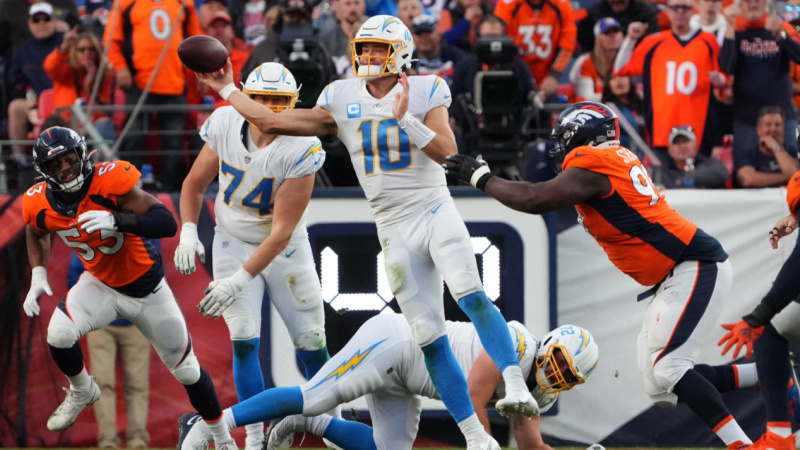Analysis
12/1/21
8 min read
The Urgency Meter: Analyzing 4th Down Decisions from Week 12

Last week, we introduced The Urgency Meter which is The 33rd Team’s algorithm for the decision making process on fourth down. We have taken some of the big fourth down decisions from Week 12 and will break down what the model thinks and why.
LA Chargers v Denver Broncos
The Chargers have not been reluctant to go for it on fourth down in the 2021 season. Some may attest this to progressive analytics whereas Brandon Staley will often offer the reasoning of “We have Justin Herbert.”
Whatever the Chargers actual decision making behind the process, the Urgency Meter looks at a number of inputs that then compare to data from 2018 to the latest week in 2021.
For the model to get its prediction, it needs to know the current situation of the game:
The Chargers were down 14 points early in this game and the Chargers needed to get something going on offense. Herbert led a drive that brought the Chargers to the Broncos 35 where it stalled on 3rd down leading to a 4th and 2.
So the current situation for Staley was as follows:
- Current Points Differential: -14
- Field Position: Opponent 35
- Approximate Field Goal Distance: 52 yards
- Yards to First Down: 2
- Time Remaining: 37:09
When we input these variables into our decision making model, we get an Urgency Meter score of 0.75.
Remember, The Urgency Meter outputs an urgency score between 0 and 1. Anything above 0.5 is suggesting to go for it on 4th down. The closer the score is to 1, the greater the urgency.
The Urgency Meter is agreeing with the Chargers decision to go for it in this instance.
Why did The Urgency Meter suggest to go for it?
The model output the following:
- Probability of First Down: 41%
- FG Distance: 52
- Expected Points from Drive: 1.4
- Expected Points if Kick: 1.5
- Expected Points for Opposition on Current Drive: 1.74
- Expected Points Rest of Game Possession Team: 14
- Expected Points Rest of Game Team Not in Possession: 12
- Expected Differential: -10.76
- Urgency Score: 0.75
*Expected Points from Drive = (Average Points Scored from Position * Probability of First Down)
*Expected Points for Opposition on Current Drive = (1-Probability of First Down) * (Average Points Scored from Position)
The above bullet points are the variables that were taken into consideration when defining the final score. Based off of previous data, it was determined that the probability of the Chargers getting the first down was 41%.
Based on the field position and the probability of getting the first down, the expected points for the drive at that point in time was 1.4 which is slightly less than the expected points for a field goal at 1.5. It’s interesting to note that the expected points for the opposition on the current drive is 1.74. Viewing this drive in isolation, the optimal decision would be to punt. This, however, is exactly what The Urgency Meter is trying to avoid. We want to avoid thinking about only certain variables for one drive and instead digest all the numbers for the rest of the game by predicting how many more points both teams can expect to score based on the number of predicted possessions, remaining time left and the average drive time per team.
Note that expected points per drive is calculated based on teams average points per field position over the last three seasons. The model looks at where the team would be should they get the first down and what the league average points are from that field position. This is then multiplied by the probability of getting the first down to see the expected points at that moment in time.
What is also interesting to note is that Denvers’ expected points should the Chargers elect to go for it is 1.74 based on the probability of the Chargers failing to get the first down and the field position they would then start from.
The Expected Differential is the model's prediction on what the difference in score will be by the end of the game based on the current drives’ situation and remaining time left which leads to a forecast of total remaining possessions and the points teams can expect to take from those possessions. Here, it is predicting the Chargers will score 13.95 points on average from this point onwards (they scored 13) and the Broncos will score 11.88 points (they scored 14).
The model here is predicting the Chargers to lose by 10.76 points.
These variables combined lead to an Urgency Meter Score of 0.75 indicating that the Chargers have a strong need to go for it.
What Actually Happened?
The Chargers went for it and failed to get the first down. The Broncos went three-and-out before eventually winning the game by 15 points.
LA Rams v Green Bay Packers
The Rams made a conventionally contentious decision to go for it on 4th down in the first quarter from their own 29 yard line down 7 with 1 yard to go to get the first down. Here at The 33rd Team, we jumped up off our seats with delight at the chance to break down what may have been going on in Sean McVay's head or the Rams Analytics department by looking at what our own Urgency Meter suggested doing and why:
- Probability of First Down: 48%
- FG Distance: 88
- Expected Points from Drive: 2.37
- Expected Points if Kick: 0.03
- Expected Points for Defending Team on Current Drive: 2.5
- Expected Points Rest of Game Possession Team: 20
- Expected Points Rest of Game Team Not in Possession: 16
- Expected Differential: -3.42
- Urgency Score: 0.58
The probability of getting the first down was determined to be 48%. This leads to an expected points of 2.37 for the drive. Ironically, once again the opponents team has a slightly higher expected points from the current drive (2.5) due to the field position should the Rams fail to make the first down. A field goal distance of 88 yards yields an expected field goal points of barely above 0.
With a ton of time remaining, the model predicts the Rams to score 20.04 points from this point onwards (they scored 28) and the Packers to score 16.35 points (they scored 29) with the Rams to lose by 3.42 points (they lost by 8).
With all these variables taken into account, The Urgency Meter Score was 0.58 - suggesting that the Rams were in fact correct to go for it at this point in time.
What Actually Happened?
The Rams failed to get the 4th down and Green Bay took over before proceeding to convert a field goal. Green Bay’s expected points at the time of the 4th down were 2.5 and they finished that series with 3. Green Bay went on to win the game 36-28.
Washington Football Team v Seattle Seahawks
The Football Team have continued their resurgence notching their third straight win since their bye week on Monday night. This comes mainly from the overall improved quality play of the team but provides us with the excellent opportunity to analyse whether “Riverboat Ron” lives up to his nickname.
Let’s set the scene for Monday night. The Football Team were leading by 8 with 2:25 remaining in the 4th quarter. They had the option to take a 20 yard chip shot field goal to make it a two possession game.
What makes this decision particularly interesting is that Washington lost their kicker on Monday night, almost forcing them to go for it on 4th down with 3 yards to goal. For the interest of the exercise, let’s run the model to see what it would score with and without the kicker.
- Probability of First Down: 40%
- FG Distance: 20
- Expected Points from Drive: 2.79
- Expected Points if Kick: 2.99
- Expected Points for Opposition on Current Drive: 1.33
- Expected Points Rest of Game Possession Team: 2
- Expected Points Rest of Game Team Not in Possession: 2
- Expected Differential: 11.83
- Urgency Score: 0.23
At 20 yards, the expected points on the field goal are a perfect 3. Essentially there is next to no chance the kicker misses this attempt and thus seals the game for Washington for an overall points differential of 11.83. The Urgency Meter Score is a small 0.23 suggesting not to go for the touchdown on 4th and goal.
When the model is rerun to minimize the expected points of the kicker (given there was none), the following results entail:
- Probability of First Down: 40%
- FG Distance: 20
- Expected Points from Drive: 2.79
- Expected Points if Kick: 0.5
- Expected Points for Opposition on Current Drive: 1.33
- Expected Points Rest of Game Home: 2
- Expected Points Rest of Game Opposition: 2
- Expected Differential: 9.33
- Urgency Score: 0.29
The only major change is the overall differential which is expected to be 8.83 in favor of Washington. The increased the Urgency Meter Score to 0.29 which moves it closer to needing to go for it but due to the lack of time remaining and Washington's current lead, the model is suggesting that regardless of what the Football Team choose to do, it shouldn’t have a major impact on the outcome as they should go on to win the game regardless.
This presented an interesting situation for the model which effectively replied with “It’s unlikely the decision will have any bearing on the result of the game”
We thought it was a huge decision watching the game live but the data suggests the hard work had been done at that point and the win should be in the bag regardless of the outcome on 4th down.
What Actually Happened?
Washington failed to get the touchdown on 4th down with Seattle taking over. Seattle proceeded to march down the field and get a touchdown before failing to get the two point conversion. Although Washington almost did throw away the lead, the win was in fact secured despite the decision on the 4th down.








